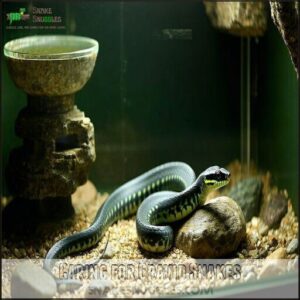This site is supported by our readers. We may earn a commission, at no cost to you, if you purchase through links.

Look for swelling in the mid-to-hind section of her body—it’s like she’s carrying a little snake pouch.
She might bask more often to regulate her temperature or lose interest in food.
Behavior can shift too; she may coil loosely, lie on her side, or appear restless.
Some snakes even show subtle color changes or shed their skin more frequently.
Keep an eye on her movements and appetite, as these can speak volumes.
Curious about how to care for her during this time? Let’s explore further to understand the best approach for caring for her.
Table Of Contents
- Key Takeaways
- Snake Reproduction Basics
- Identifying Gravid Snakes
- Physical Changes During Pregnancy
- Behavioral Changes in Pregnant Snakes
- Caring for Gravid Snakes
- Frequently Asked Questions (FAQs)
- How do you know if a gravid snake is pregnant?
- What happens if a snake is pregnant?
- How do you know if a gravid ball python is pregnant?
- What does a pregnant snake look like?
- How do I know if my baby is gravid?
- What is a gravid snake?
- How can you tell if a snake has eggs?
- How long is gestation for snakes?
- How does a pregnant snake look?
- How long are ball pythons gravid for?
- Conclusion
Key Takeaways
- Check for swelling in the midsection or visible lumps, which are clear signs of gravidity.
- Watch for behavioral changes like restlessness, nesting instincts, or reduced appetite.
- Notice temperature regulation shifts, such as basking more or seeking cooler spots.
- Look for physical changes like a pre-lay shed, lighter scales, or visible skin between scales.
Snake Reproduction Basics
Understanding snake reproduction helps you recognize whether your snake is gravid or not. Snakes reproduce through live birth, egg-laying, or even asexual methods like parthenogenesis, depending on the species.
Viviparous Vs Oviparous Snakes
Regarding snake reproduction, the big question is egg vs. livebirth.
Viviparous snakes, like boas, give birth to live young, resembling mammalian pregnancy.
Oviparous snakes, such as corn snakes, lay eggs that hatch externally.
Each method offers evolutionary advantages—livebirth suits colder climates, while egg-laying thrives in warmer areas.
Snake pregnancy signs vary based on these reproductive strategies, and understanding evolutionary advantages is key to grasping the differences between viviparous and oviparous snakes.
Species-Specific Reproductive Methods
Each snake species has unique breeding habits.
Boa reproduction involves live birth, while Corn Snake oviposition requires laying eggs.
Viper viviparity combines live-bearing traits, and Python gestation spans weeks to months.
Egg-Eater gravidity showcases fascinating adaptations.
These snake reproduction methods reflect nature’s variety, ensuring survival in diverse environments.
Understanding these helps you better care for your pet snake’s specific needs.
Successful breeding also relies on consistent temperature control during the cooling period, which is crucial for successful breeding and requires consistent effort to maintain the right temperature.
Parthenogenesis in Snakes
Parthenogenesis, a form of asexual reproduction, lets female snakes produce offspring without a male. It’s rare but fascinating, often triggered by environmental factors or stress.
Parthenogenesis allows female snakes to reproduce without males, showcasing nature’s adaptability and the surprising resilience of snake species.
This unique snake reproduction method raises questions about genetic diversity and evolutionary advantages. Asexual reproduction, or virgin births, are actually more common in snakes than previously understood.
- Occurs in species like copperheads and cottonmouths.
- Produces genetically identical offspring.
- Triggered by environmental changes.
- Offers insights into snake pregnancy.
- Impacts conservation efforts.
Identifying Gravid Snakes
You can spot a gravid snake by observing changes in its appetite, behavior, and body. These signs often include reduced eating, restlessness, and visible bumps along its midsection.
Changes in Appetite and Temperature
Noticing appetite reduction? Pregnant snake signs often include skipping meals for weeks.
Temperature preference shifts, too—your snake might alternate between basking behavior and cooling strategies. These metabolic changes help with embryo development.
A healthy snake typically shows active foraging behavior, but this may decrease during gestation. Watch for unusual temperature regulation patterns during snake gestation.
| Indicator | Behavior | Reason |
|---|---|---|
| Appetite Reduction | Refusal to eat | Slower digestion during pregnancy |
| Basking Behavior | Seeking warmth | Supporting embryo growth |
| Cooling Strategies | Lying in cooler areas | Preventing overheating |
| Temperature Regulation | Alternating hot/cool spots | Balancing metabolic changes |
| Snake Gestation Signs | Appetite/temperature shifts | Pregnancy adaptation |
Behavioral Changes and Restlessness
Gravid snake behavior often includes snake restlessness and behavioral changes.
You might notice reduced lethargy, unusual postures, or even nesting instincts kicking in as your snake rearranges its enclosure.
Aggression causes can stem from hormonal shifts, making handling tricky, and restlessness triggers, like discomfort or environmental shifts, may also play a role in behavioral changes.
Watch for these snake behavior changes to better understand their needs and adjust your approach accordingly.
Visible Signs of Pregnancy
Look closely for a lumpy midsection or bulging sides—these are classic signs of a gravid snake.
Visible swelling near the abdomen or a "gravid pyramid" shape, where the spine appears more pronounced, can hint at developing eggs.
If you notice visible skin between scales or subtle weight gain, these snake body changes confirm pregnancy is likely underway, indicating a gravid condition.
Physical Changes During Pregnancy
During pregnancy, your snake’s body goes through noticeable physical changes that can help confirm gravidity.
From a lumpy midsection to shedding and weight gain, these signs are key indicators to watch for.
Color Changes and Lumpy Midsection
Snake pregnancy signs often include a lumpy midsection, resembling a "lumpy pyramid," as eggs or embryos develop.
You might notice abdominal swelling or visible lumps along the body. A gravid snake may also display a color change, like scale lightening, enhancing its gravid appearance.
These snake body changes often occur before a pre-lay shed, signaling pregnancy progression. The combination of these signs can indicate that the snake is preparing to lay eggs, which is an important milestone in the reproductive cycle.
Shedding and Nesting Behavior
Pregnancy brings noticeable shedding and nesting behavior in snakes.
A pre-lay shed often signals egg deposition is near. Watch for nesting preparation like burrowing or rearranging tank items.
These snake pregnancy signs show readiness for clutch attendance. Post-lay behavior may include guarding the eggs.
Such snake breeding signs highlight a gravid snake’s instincts kicking in. Providing a suitable snake nesting box can further encourage successful egg-laying.
This process is crucial for the health and successful breeding of the snakes.
Increased Girth and Weight Gain
As your snake prepares for egg-laying, you might notice visible swelling or a "lumpy pyramid" body shape.
Measuring girth can confirm gradual increases, while palpating eggs in larger species reveals firm, round structures.
Snake weight gain varies, but scale visibility often hints at growth.
An increased appetite early on may shift to reduced feeding closer to delivery—classic snake pregnancy signs.
Behavioral Changes in Pregnant Snakes
Pregnant snakes often show noticeable shifts in behavior, making these changes key indicators of gravidity.
You might observe increased aggression, restlessness, or unusual movement patterns as your snake adjusts to its pregnancy.
Increased Aggression and Restlessness
During snake pregnancy, hormonal influence often triggers aggression and restlessness.
Your usually calm snake might show defensive behavior or react poorly to handling changes.
Environmental stressors, like sudden noise or temperature shifts, can amplify this.
Keep in mind, individual variation plays a role—some gravid snakes remain docile.
Understanding these behavioral changes helps you provide a peaceful, supportive environment for your snake.
Changes in Movement and Activity
After noticing aggression, watch for snake pregnancy behavior changes like reduced movement or unusual postures.
Pregnant snakes often display restlessness patterns, coiling behavior, or pressing against cooler surfaces.
You might see them seeking enclosure corners or lying upside down, which isn’t typical, and they might also exhibit defensive snake postures if feeling threatened.
These snake pregnancy symptoms signal behavioral changes, helping you recognize their needs and make them comfortable during this unique time.
Caring for Gravid Snakes
Taking care of a gravid snake means creating a safe environment where she can thrive.
You’ll need to monitor her closely for any signs of discomfort or health issues.
Providing Suitable Environments
Creating a stress-free environment for snake pregnancy starts with proper temperature gradients and humidity control.
Add a nest box with a nesting substrate like coco chunks or aspen for snake nesting. Secure the enclosure and include hiding spots to support nesting behavior.
Consider buying a snake nesting box for a secure laying environment.
A clean, safe space encourages healthy egg-laying. Think of it as setting up a cozy nursery for your reptile!
Reducing Stress and Promoting Health
To keep your gravid snake healthy, focus on stress reduction through enclosure enrichment, like hiding spots and soft bedding.
Maintain proper hydration by ensuring fresh water is always available. Adjust snake handling techniques to minimize disturbance.
Meet nutritional needs with balanced meals. Regularly check for signs of discomfort, and don’t hesitate to seek veterinary care for ideal snake pregnancy care and overall health.
Choosing the right bedding is important for gravid snakes is crucial for their overall health, and ensuring they have a comfortable environment is key to proper hydration and balanced meals.
Monitoring for Signs of Distress
Watch for pregnancy-related issues to guarantee your snake’s wellbeing. Signs like breathing difficulties, abnormal shedding, or regurgitation can indicate distress. Monitor lethargy severity and check for scale rot to address problems early.
One should also be aware that environmental factors cause stress.
Here’s what to look for:
- Sudden snake aggression or refusal to eat.
- Changes in movement, like unusual coiling.
- Stress reduction needs, such as quieter surroundings.
Frequently Asked Questions (FAQs)
How do you know if a gravid snake is pregnant?
Could your snake be expecting?
Look for lumpy sides, a “pyramid” shape, or visible skin between scales.
She might avoid food, seek cooler spots, or act cranky.
Nesting behaviors and swelling confirm it further.
What happens if a snake is pregnant?
If your snake’s pregnant, it’ll need extra care.
Expect appetite changes, restlessness, or nesting behavior.
Provide a cozy, stress-free environment with proper temperatures and hiding spots.
Watch for visible swelling or unusual movements as birth approaches, and be aware of nesting behavior.
How do you know if a gravid ball python is pregnant?
Around 70% of snakes lay eggs, but a gravid ball python shows clear signs like reduced appetite, nesting behavior, and a lumpy midsection.
You might also notice her preferring cooler spots or acting more defensive.
What does a pregnant snake look like?
A pregnant snake often looks swollen in the middle, with a lumpy, pyramid-like shape.
You might notice visible bumps, lighter scales, or stretched skin between scales.
It may also act restless or avoid heat sources, which can be a key indicator, but one notable sign is that it often looks swollen.
How do I know if my baby is gravid?
Don’t worry, it’s easier than you think!
Look for a lumpy midsection, reduced appetite, or nesting behavior.
Gravid snakes often rest in cooler spots, show restlessness, or display visible bumps along their body.
What is a gravid snake?
A gravid snake is basically pregnant, carrying developing eggs or embryos.
You might notice a swollen midsection, reduced appetite, or behavioral changes like nesting or seeking cooler spots.
It’s nature’s way of preparing for new life!
How can you tell if a snake has eggs?
Spotting eggs in a snake is like finding hidden treasure—look for a lumpy midsection, visible skin between scales, and a “pyramid” shape.
Add reduced appetite, restlessness, or nesting behaviors, and you’ve got clues!
How long is gestation for snakes?
Snake gestation varies by species, ranging from weeks to months. Ball pythons take 44–54 days, while boas can go 5–8 months. Smaller species like corn snakes average 30–45 days.
How does a pregnant snake look?
Like a balloon slowly inflating, a pregnant snake shows a lumpy midsection as eggs or embryos grow.
You might notice swelling, visible skin between scales, reduced appetite, and occasional awkward positions like lying on its back, which can be a clear indication of pregnancy, making it a visible sign.
How long are ball pythons gravid for?
Ball pythons are typically gravid for about 4 to 5 weeks.
During this time, you might notice subtle changes like reduced appetite, nesting behavior, or a visible swelling as the eggs develop inside her.
Conclusion
Before you grab your snake’s “pregnancy test,” remember that observing her behavior and physical changes is key.
Signs your snake is gravid include swelling, basking more, shedding, and shifts in appetite or activity.
Watching for these clues helps you provide the right care, like a stress-free environment and proper temperature.
Gravid snakes need your attention and patience, so stay alert for distress signals.
With the right approach, you’ll support her through this fascinating stage.
- https://www.livescience.com/65632-anaconda-snake-gives-virgin-birth.html
- http://www.ncbi.nlm.nih.gov/pubmed/11754034
- https://en.wikipedia.org/wiki/Parthenogenesis_in_squamates
- https://www.cbsnews.com/news/asexual-reproduction-extremely-common-among-snakes/
- https://webapps.fhsu.edu/ksherp/bibFiles/22157.pdf














